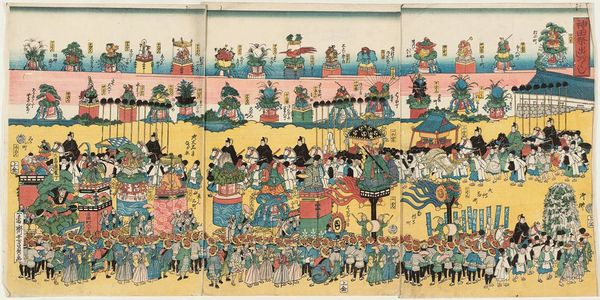The Meiji Constitution
The Meiji Constitution: A Fresh Breath of Western Civilization

Of the various pieces of artwork that depict Japan’s adoption of the Meiji Constitution, Migata Toshihide’s “Parade for Adoption of the Constitution” skillfully captures a pivotal moment in the modernization of Japan. During this time period, most of the Japanese were collectively excited and proud of the establishment of this “new” Japan. This piece successfully captures the overall celebratory and patriotic attitude towards the modernization of Japan by combining Western carriages and horses with more traditional festivals. The combination of the two traditions ultimately showcases the transition from the Japanese shogunate to the imperial government of Japan.
Prior to the Meiji Constitution, Japan had no written constitution: most of its social and political power rested within the oligarchy of samurai and nobility. However, from 1882 to 1888, Ito Hirobumi conducted research on different government systems overseas and went through various drafts with Japanese statesmen and foreign advisors. The promulgation and parade of the Constitution was held on February 11, 1889, commencing with the Emperor holding a private ceremony in the Imperial Palace and then moving to the Throne Room where he formally decreed the Constitution. The parade that followed soon after featured floats filled with traditional Japanese themes, but with the Emperor and Empress in Western clothing, there was still a reminder of a new foreign influence permanently within Japan.
Toshihide’s work provides commentary on the class division present in Japanese society. The Emperor (who is surprisingly depicted in person instead of behind a curtain/wall) and those who are partaking in the promulgation of the Meiji Constitution rightly take center stage in the piece. In the lower three layers, the sheer number of civilians, some of whom are portrayed as no more than faceless heads, further contrasts with the smaller upper class folk, whose clearer definition may imply the heightened importance they possess. The painting itself is divided into four different “cloud layers,” with those in the highest layer donning both Western and traditional raiment of a more upper-class wardrobe. These influential folks still maintained control over the other classes, demonstrating that the influx of Western ideals did not interfere with the pre-Meiji social hierarchy.
Other Japanese traditions were also emphasized over Western ideals, as shown in the first panel’s white elephant on a float, a Buddhist symbol associated with the Hana Matsuri celebration (the Flower Festival, or Buddha’s Birthday). Additionally, the auspicious Tai fish (red snapper fish) of celebration are on kites and floats throughout the print. The traditional roots of the Constitution Parade manifest itself in Yoshikazu’s “The Kanda Festival Parade,” which conveys the immense sense of pride evident in Toshihide’s work. In both prints there are floats featuring entertainment, carrying important nobles through the parade, and illustrating the rigidity of the class system. The commoners wearing celebratory straw hats were placed at the lowest point, and the officials (samurai in Yoshikazu’s print) were at the highest level of the parade. Another important similarity is the presence of labels throughout the print signifying the various communities represented in the parade.

Toshihide also incorporates certain aspects of Western society throughout “Parade for Adoption of the Constitution.” In the middle of the painting, though the Sacred Emperor and the chrysanthemums dominate the scene, there is a parliament-like setup of the room surrounding them. The officials are seated around the Emperor and dressed in Western-style suits, similarly structured to a European parliament. This combination of Western and Japanese governments illustrates the impact of Western society on Japan and signifies the transition from shogunate to imperial government. The influence of Western culture is also evident in the red horse-drawn carriages and soldiers to the right of the Emperor’s Throne Room. Here, Toshihide captures the Japanese sense of unity and patriotism through their own of military parade.
Ultimately, Toshihide’s “Parade for Adoption of the Constitution” skillfully captures the prideful and celebratory attitudes of the Japanese towards the transition from shogunate to imperial government. While the painting highlights how Western civilization has shaped a “new” Japan through its portrayal of the government and military parade, Toshihide’s composition also illustrates how the “new” Japan continues to uphold its traditions through its rigid social hierarchy and symbolic floats.
Devin Busono (‘22), Jin Sebastian (‘23), Emily Sun (‘22), Gali Zaborowski (‘20)